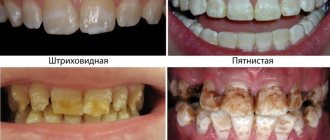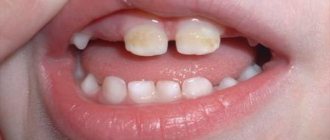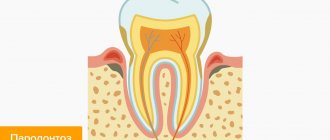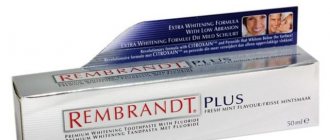Tooth decay can lead to loss of smile aesthetics. Dental defects are noticeable to interlocutors, and if the process of necrosis develops rapidly, then the person will have bad breath. But these are not all the unpleasant consequences of having rotten teeth: rotting affects the entire body, as it leads to a decrease in immunity and the spread of infection to other organs and systems.
How and why does tooth decay occur?
The condition of teeth is constantly influenced by various unfavorable factors. And if a person does not maintain oral hygiene, then their negative effects destroy tooth enamel even faster. Tooth decay is the decay of hard dental tissues against the background of an inflammatory-purulent process that occurs in many dental diseases. Among them:
- Caries.
- Periodontal disease.
- Gingivitis.
- Granuloma.
- Cysts on the roots.
Caries is a widespread disease in which the integrity of the enamel is damaged, and then the process of decay begins. First, the disease leads to disruption of the structure of the enamel layer, and subsequently to its destruction, during which carious holes are formed on the tooth surface. When a hole appears in a tooth, the process of destruction of hard tissues accelerates because food begins to get stuck in it and undergoes rotting. Following the enamel, dentin begins to rot, after which the pulp is destroyed.
Incisors, fangs and molars can rot not only from the outside, but also from the inside, since the process of suppuration and destruction can spread from the root. The localization of the focus of carious inflammation and the direction of its spread depends on the cause of the development of dental disease. Photo No. 1 shows a molar that has rotted from the inside, and photo No. 2 shows teeth that are rotting from the gums - only a dentist can determine what to do in this or that case.
Why do teeth rot in adults?
The development of caries and other dental diseases occurs under different circumstances, including:
- Insufficient oral hygiene or its complete absence.
- Poor nutrition, accompanied by the development of excess or deficiency of microelements and vitamins in the body.
- Failure to follow the rules of eating: chewing very cold or very hot food, combining hot and cold, biting into very hard foods.
- Disturbance of metabolic processes in the body.
- Endocrine diseases and temporary hormonal imbalances, due to which the protective properties of saliva are weakened.
- Pathological processes that occur during pregnancy and are associated with the outflow of nutrients from the mother’s body to the developing tissues of the fetus.
- Weak immune activity.
- Hereditary predisposition and improper formation of the dentofacial apparatus.
- The effects of nicotine and alcohol.
- The effect of toxic substances in unfavorable environmental conditions or harmful working conditions.
- Infectious processes due to injuries.
- The presence of untreated infectious processes in any part of the body.
When visiting a dentist, you rarely hear exactly why a particular dental disease has developed. Most often, unfavorable factors act on dental tissues in a complex manner and over a long period of time.
Why do children's teeth rot?
Teeth rot not only in adults, but also in children. In addition to the reasons described, children’s teeth are affected by additional factors that often arise due to the fault of parents:
Photo: rotten baby teethImproper nutrition of the mother during pregnancy, due to which the formation of bone and dental tissue of the fetus is abnormal.
- The effect of toxins and medications that enter the mother’s body through smoking, drinking alcohol or self-medicating.
- Long-term use of pacifiers and bottle nipples.
- Night feeding - at night, food particles linger in the mouth for a long time and rot due to the activity of bacteria.
- Late and incorrect teaching of children to maintain hygiene.
- Eating large amounts of sweets, the remains of which create favorable conditions in the mouth for the proliferation of microbes.
Causes of pathology
Destruction of enamel and other parts, followed by a purulent-inflammatory process, occurs under the influence of negative external and internal factors. For successful treatment of pathology, it is important to find out why teeth rot from the inside - there are various reasons for this phenomenon.
| Factors affecting dental health | |
| Bad habits | These include smoking, drugs, and alcoholic beverages. An intensive process of destruction of enamel and pulp occurs due to prolonged smoking. It is the resins in tobacco that disrupt blood flow, the cells do not receive enough nutrients, and the gums under the tooth rot. Alcohol abuse also affects oral health. |
| Hereditary predisposition | Often the problem of the purulent process appears even in young children who have inherited bad teeth. In order to protect the child as much as possible from their loss, it is necessary to carefully monitor the personal hygiene of the baby’s oral cavity from the moment of teething. |
| Improper hygiene | If you do not regularly cleanse food debris and plaque from the enamel, there is a very high risk of developing purulent destructive processes. In addition to using paste and brushes, rinse your mouth after each meal and use a special floss. |
| Unbalanced diet | Eating right is important for oral health. A lack of useful microelements always manifests itself, the body’s defenses weaken and it is much more difficult for it to fight pathogenic microorganisms. Sweets, excessive consumption of coffee and strong tea, fresh juice, and citrus fruits have a negative effect. |
| Environmental factors | Polluted water, air or soil also have an impact on human health. If there is not enough fluoride in drinking water, dental diseases develop. |
| Weak immunity | Even with daily hygiene and a balanced diet, pathologies in the oral cavity can occur. Women during pregnancy and breastfeeding are also at risk of destruction and other ailments. For such people it is important to take vitamin complexes. |
Causes of purulent process in the oral cavity
Pathology also develops due to disruption of internal organs and chronic processes in the body:
- changes in hormonal levels;
- chronic diseases of the stomach and intestines;
- disorders of the kidneys and liver;
- various infectious diseases;
- pathologies of the upper respiratory tract.
In any case, it is necessary to determine why the teeth are rotting and begin treatment immediately to stop tissue destruction.
Causes of dental diseases
Symptoms of dental decay
A person may find out that his tooth has begun to rot too late - when the process of tissue destruction begins to develop in full force and will already cause great harm to the dentin and pulp. The main symptoms of a purulent process are:
- The appearance of stains on the top of the crown or in the cervical area if the root of the tooth rots. If a tooth rots from the inside (from the root canals), then the initial stages of necrosis can only be detected using x-rays: the visible surface of the crown turns black in the later stages of decay.
- Deformation of the tooth surface, the appearance of holes.
- Putrid, rotten odor from decaying tissues, caused by fetid waste products of bacteria that cause the process of decay.
- The appearance of an unusual, unpleasant taste in the mouth due to the entry of pus from the carious cavity or pulp chamber into the oral cavity.
- The appearance and gradual intensification of aching pain.
- Temperature increase.
- Increased accumulation of plaque with pathogenic microflora not only on the dentition, but also on the surface of the tongue or tonsils.
If a tooth has rotted to the root, its crown may completely crumble. Against the background of the destruction of the rotten tooth root, the patient may experience more frequent headaches.
Smoking
So what is its impact? Why do smokers' teeth rot from gums? The fact is that nicotine leads to impaired blood circulation in the tissues of the oral cavity. As a result, beneficial substances do not reach them. In the absence of adequate nutrition, pathological processes begin to develop in the gums, which cause unwanted changes in bone tissue. As a result, the roots of the teeth stop receiving the components necessary for proper functioning. Putrefactive processes can occur in one or several teeth at once.
What are the dangers of rotten teeth, consequences for the body
Many people ignore the process of tooth decay unless it is accompanied by severe pain. But the consequences of the carious process can be unpredictable and dangerous . If you have rotten teeth, the following complications may develop:
Abscess in the gumDestruction of bone tissue of the musculoskeletal system.
- Endocarditis is inflammation of the lining of the heart.
- Inflammatory pathologies of the kidneys.
- Infections of ENT organs.
- Psychological complexes due to discomfort during communication and dissatisfaction with the appearance of the dentition.
- Purulent-inflammatory diseases in the gums (abscesses, phlegmons) and, as a result, the spread of infection throughout the body, leading to general intoxication.
The health of baby teeth greatly affects the condition of the permanent buds. Therefore, if nothing is done about the decay of milk dental tissues, in the future the child may have big problems with the formation of a permanent dentition.
Excessive alcohol consumption
Why do teeth rot from the inside? Alcohol has a toxic effect on the body. Important microelements and vitamins begin to be absorbed worse. As a result, calcium is washed out, which is the basis of dental tissue. The protective layer of enamel is destroyed under the influence of aggressive acids present in wine drinks. All this leads to the development of putrefactive processes in the structure of dental tissue.
It is worth noting that the group of low-alcohol drinks, which are considered harmless, pose the greatest danger. They contain a huge amount of sugar, which also leads to the destruction of enamel.
What to do if your teeth are rotting
Rot inside the tooth is dangerous for the entire body. Therefore, at the first signs of decay of dental tissues, you should go to the dentist.
Before providing first aid, it is recommended:
- Rinse your mouth with a herbal decoction that has anti-inflammatory and antimicrobial effects. It's better to take chamomile and sage.
- Rinse your mouth with a pharmaceutical antiseptic: Chlorhexidine, Miramistin.
- Thoroughly clean the surface of the dentition to prevent the accumulation of soft plaque and its transformation into hard tartar: bacteria multiply under its surface and spoil the enamel even faster.
- You should not try to remove pus yourself by picking at the enamel with a sharp object. This action will provoke even greater destruction of damaged tissue.
- On the side of the jaw where the rotten tooth is located, it is better not to chew anything so that food does not penetrate into the carious holes.
- After eating, you need to rinse the remaining pieces of food with a weak saline solution or boiled water.
How to treat
First of all, it is necessary to establish the main cause of rotting. If treatment is carried out without identifying the main factor that caused the process of tooth decay, then this will only bring a temporary effect. Therefore, it is important to first undergo a complete examination.
For preventive treatment, a number of medical treatments are undertaken: cavity sanitation with special solutions (chlorhexedine, rotokan), pain relief (cholisal gel), cleaning teeth and applying protective varnish, rinsing the mouth with herbal decoctions, etc.
The entire process of examining and treating tooth decay should be performed as follows:
- To begin with, an X-ray examination is performed. Typically, x-rays are taken of areas that are inaccessible for visual inspection;
- Next, the rotting zone is determined. In most cases, rotting areas in patients cause an infected lesion of the periodontal tissue;
- In the subsequent period, a plan is drawn up for therapeutic therapy, removal or use of prosthetics; usually this procedure is performed if there is poor condition in individual or all units of the dentition;
- The affected tissues of the oral cavity are treated. During processing, disinfectants are used - Chlorhexidine, Miramistin, Rotokan;
- Special painkillers in the form of a gel can be applied to the area of gum tissue near the affected tooth. It has a good effect, it has antimicrobial, analgesic, anti-inflammatory effects;
- Soft and hard plaque is removed from the enamel surface. The doctor must explain how important it is to follow all the rules for caring for the teeth, as well as the oral mucosa;
- Next, antibiotic therapy is carried out.
Attention! Antibacterial therapy will help eliminate the inflammatory process. The doctor takes a swab from the oral cavity, with which you can determine the causative agent of the pathological process. A sensitivity test is also performed. According to the data obtained, an antibiotic is prescribed that will have a detrimental effect on harmful microorganisms; - In the subsequent period, filling of all carious cavities is performed. The doctor must apply a fluoride-containing varnish to the enamel, which is necessary to strengthen the dental tissue;
- Rinsing the mouth with herbal decoctions of chamomile, sage, calendula, and oak bark is prescribed. This procedure will speed up the healing process;
- If the lesion is severe, in which complete destruction of the dental tissue is observed, a complete tooth extraction is performed.
Treatment in dentistry
Whether a tooth can be treated depends on the severity of the carious process, so doctors first prescribe x-rays to patients. If the situation is not critical and the dentist can save the tooth from rotting, he carefully cleans it of accumulated deposits (plaque and stone) and begins treatment:
- Anesthesia is performed.
- All areas of enamel affected by the carious process are removed, and the rotting pulp must also be removed.
- The dental cavity is washed with an antiseptic.
- The integrity of the surface is restored with filling material. After the filling is installed and hardened, the patient must check the bite: if discomfort is felt, the excess layer of filling material must be removed.
Teeth that are rotting from the gums are treated in the same way, but photopolymer materials are usually used to fill them. They harden quickly, are characterized by increased strength and high aesthetics.
The dentist may prescribe an antibiotic to prevent the infection from spreading throughout the body. For severe pain, an analgesic is prescribed.
There are methods that can be used to prevent damage to dental tissues by cariogenic bacteria. Almost all dental clinics carry out remineralization - strengthening the enamel structure with special preparations. In a hospital or at home, you can perform fluoridation - saturating the enamel with fluoride.
Prevention measures
The process of suppuration does not occur in one day, therefore, with high-quality prevention, such a complex disease can be avoided.
Personal hygiene
Daily oral care should become a habit from early childhood. High-quality oral hygiene products, rinsing your mouth after every meal, and using herbal solutions will help reduce the risk of dental diseases many times over.
Recommendations! You need to choose the right toothpaste and brush according to your age.
Visit doctor
A visit to the dentist should be repeated every six months. You can't wait for acute pain to see a doctor. Preventive examination becomes the key to oral health in both adults and children.
Preventative visit to the dentist
Additional care
In addition to daily cleaning, it is important to remove pieces of food using a special thread or toothpicks in hard-to-reach places. After all, the main cause of the formation of plaque and stone on the enamel is bacteria that feed on the remnants of daily food. In addition to tooth decay, bad breath is also eliminated with regular hygiene.
Dental floss
Balanced diet
Eating nutritious food can prevent many problems and increase the body's defenses. You should exclude carbonated drinks from the menu, limit sweets, chocolate, caramel, which are a habitat for microbes. Products should be enriched with calcium and vitamin D. Greens, sea fish, fresh fruits and vegetables, cottage cheese and milk will help strengthen tooth enamel.
Recommendations! People with a hereditary predisposition to dental diseases, as well as pregnant and lactating women, should definitely visit the dentist.
Proper oral care
A rotten tooth is a dangerous problem - only a specialist can tell you how it affects the body, effective methods of treatment, prevention and preservation of the damaged area.
Do I need to remove rotten teeth?
If a tooth root or crown is completely rotted, it cannot be restored. Such a tooth cannot be left in the jaw so that its purulent contents do not spread to the surrounding tissues. If there is rot in the root canals, it is not possible to make artificial crowns, since they will not be able to fix on the destroyed tissues. Therefore, in advanced situations, dentists prescribe the removal of a rotten tooth, and this operation cannot be refused. After removal, a course of antibiotics may be prescribed.
To prevent your teeth from rotting, you need to regularly monitor their condition. To maintain dental health, you need to adhere to a nutritious diet and maintain oral hygiene, as well as promptly treat any dental and internal diseases. Purulent processes are extremely dangerous, therefore, if the carious process has reached an advanced stage, you should not refuse to remove the diseased tooth.
Compliance with oral hygiene requirements
You need to start doing this from childhood. Many people know that it is important to rinse your mouth after eating, but not everyone follows this simple rule. The products contain so-called table sugar. It is a favorable environment for the development of bacteria. Plaque has a negative impact on gum tissue. As a result, they may become overly sensitive and begin to bleed frequently. Many people underestimate the danger of the adverse effects of food, since the destruction of gum tissue and tooth enamel can drag on for several years. Table sugar is found in varying concentrations in common foods such as grains, fruits, vegetables, and milk. Therefore, after every meal you need to rinse your mouth or brush your teeth.
Problems with the baby's incisors
Why does a child's teeth rot? As a rule, this pathology occurs as a result of improper nutrition of the mother during pregnancy. This has even been scientifically proven. It is for this reason that pregnant women are advised to follow a special diet. It has been scientifically proven that the predisposition to caries is inherited. If a woman had caries during pregnancy, then the child will most likely have it too.
Many young mothers are perplexed: why do their child’s baby teeth rot? Babies can develop tooth decay due to eating large amounts of sweets. Today, in order to calm the baby, parents resort to a trick: they dip the nipples in jam, honey or condensed milk. But this can lead to the development of serious pathologies.
Many parents mistakenly believe that since baby teeth are temporary, they do not need to be treated. In fact, a violation of the mineral composition of baby teeth will subsequently lead to problems in the formation of permanent teeth. Premature babies, by the way, often have such problems. In this case, a special course of treatment may be required. The pediatrician will help you choose the appropriate complex of vitamins and minerals.
So, after contacting the doctor, the following algorithm will follow:
- X-rays must be taken to determine the condition of the tooth root.
- The doctor examines the coronal part of the unit and assesses the situation.
- Construction of a treatment plan. The patient should be explained in detail about the clinical picture and methods of its treatment.
- Be sure to carry out comprehensive hygienic treatment of the oral cavity in order to thoroughly remove plaque and tartar.
- If the root is in normal condition and has no deviations, the canals are cleaned, the tooth is polished and filled. In some cases, depulpation, that is, removal of the nerve, may be required. This procedure is necessary if pulpitis is observed against the background of advanced caries.
- If the rotting process is observed at the root, then the only option is to remove the damaged unit and further prosthetics.
Incisors during pregnancy
Why do the roots of women's teeth rot while carrying a child? During pregnancy, a complete restructuring occurs in the body of the expectant mother. This is primarily due to the fact that the child takes on most of the minerals and nutrients. Therefore, the mother's body may experience calcium deficiency, which ultimately leads to tooth decay. It would be wrong to leave this problem unresolved until childbirth. Caries during pregnancy can lead to the appearance of the same disease in the child immediately after teething. Modern dentistry uses drugs and instruments that are safe for the body. They can even be used to treat women in an interesting position. In this case, the sooner medical assistance is provided, the lower the risk of complications.
The tooth has turned black at the gum! Do not delay treatment of root caries
Caries is a dental disease that is characterized by the destruction of hard tooth tissues (enamel and dentin). At the initial stage, the disease is asymptomatic, but over time a cavity forms in the dental tissues. This causes severe discomfort, pain and subsequently leads to tooth loss.
In dentistry, there are several types of caries depending on its location: fissure (the earliest stage, in which only the enamel is affected), contact (caries on the side of the tooth or destruction of the lateral surfaces of adjacent teeth), ring (circumferential damage to the enamel and dentin) and cervical. The last type is considered the most dangerous, since the destruction of hard tissues occurs near the most vulnerable spot - the root of the tooth.
Let's sum it up
The conclusions on the topic are:
- Preventing dental problems is much easier than treating them. Regular adherence to preventive measures significantly reduces the risk of teeth blackening.
- It is imperative to monitor the quality and regularity of simple household hygiene operations.
- Smokers should purchase special pastes that quickly dissolve plaque. However, the choice of paste must be approached very responsibly, since many of them contain small abrasive particles, which, although they remove stains from teeth, at the same time have a negative effect on the enamel by scratching it.
- It is necessary to quit smoking and limit the consumption of drinks with dyes.
- All types of plaque on teeth must be removed without fail, so as not to provoke the creation of an environment for the accumulation of microbes, as well as a source of infection for the body, which has a catastrophic effect on tooth enamel.
- Folk remedies for combating plaque are not the best solution. In the absence of a guarantee of getting rid of plaque, they can cause harm if used ineptly. For example, when used repeatedly, soda, although it removes plaque, also has a negative effect on tooth enamel.
Read also: Causes of bleeding from gums
Symptoms of the disease at different stages
There are four stages of caries in the root zone.
- The first stage is the formation of a white or dark spot on the tooth enamel near the gum.
- The second stage is superficial. It is characterized by further destruction of hard tissues, roughness and darkening of the enamel. At the second stage, caries near the gums can be seen with the naked eye.
- The third stage is the middle one. Characterized by the destruction of enamel and the beginning of damage to dentin.
- The fourth stage is deep. In the last stage, caries damages the deepest tissues (including the root) and reaches the pulp.
The fourth stage is deep
The initial stage of the disease is asymptomatic. Then the first visible signs of disease progression appear. If the tooth turns black near the gum, you should immediately contact your dentist. This is the first symptom indicating the presence of caries in the root region of the tooth. At the first stage, treatment of cervical caries is painless and without complications.
At the next stage of disease progression, increased sensitivity of the tooth to changes in temperature during food intake and a painful reaction to mechanical stimuli occur. Lateral caries is difficult to recognize on your own. Defects with such localization are diagnosed during an examination by a dentist or when pain occurs.
At the last stage of the disease, a noticeable dark hole is formed - a hollow in the tooth. In some cases, the carious cavity may partially extend under the gum. This leads to food getting under the gums and severe pain during chewing. Deep caries is accompanied by the destruction of all tooth tissues and causes the development of pulpitis.









